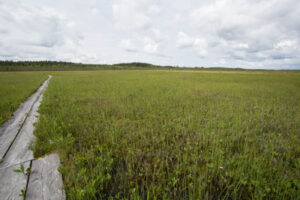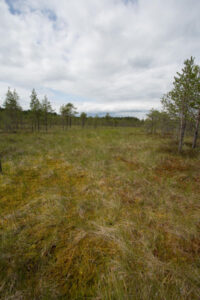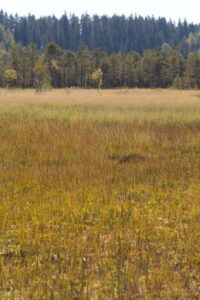Suurisuo
Skiing on the long boardwalks of Suurisuo to the swamp is easy. The valuable Suurisuo, part of the Natura network, is one of the most significant swamps in Southern Häme. The swamp complex represents southern Finnish raised bog, but it also has features of afen swamp. In a raised bog, the center of the swamp is elevated, nutrient-poor, and dependent on rainwater. Nutrient-rich waters flow to the edges of the swamp, which is reflected in the lusher swamp types along the margins. The swamp exhibits typical swamp types found in southern Finnish raised bogs, which are marked with posts as well as described in the brochure and on the website. The nature of Suurisuo is diverse, with forests along the edges and a middle part that is open bog. Suurisuo is home to several endangered and rare plant and insect species, as well as birds. There is also a birdwatching tower and excellent berry-picking areas.

This page presents the nature of Janakkala’s Suurisuon, where you can explore the various points of the nature trail in the swamp. Janakkalan Suurisuo is located on the northern side of road 292, about 13 kilometers northeast of Turenki. Suurisuo mainly consists of raised bog, with its center elevated compared to the edges. At times, there are also features of a aphen in Suurisuo. Especially in spring, the open watery southern part resembles northern Finnish aphen swamps.
The nature of Suurisuo is diverse. The edges of the swamp have forests and pine fens. The center is an open bog, with nutrient-rich fen and sedge types, as well as nutrient-poor low-statured fens. Suurisuo was originally protected by a decision of the management board of the forest company UPM’s predecessor Rosenlew in the early 1960s. Since then, it has been included in the Basic Program for Mire Protection and subsequently as part of the Natura network. The landowner of the area is UPM, and the area of the Natura site is 232 hectares. The area is also an important destination for education, research, and hiking. The University of Helsinki has used the swamp in its teaching since the 1970s.
Directions: You can reach the starting point of the nature trail by turning north from road 292 (Lammintie) to Suurisuontie on the east side of the swamp. After just a few hundred meters, the road curves left, and you arrive at a turnaround point. There is also space to park at the turnaround point.
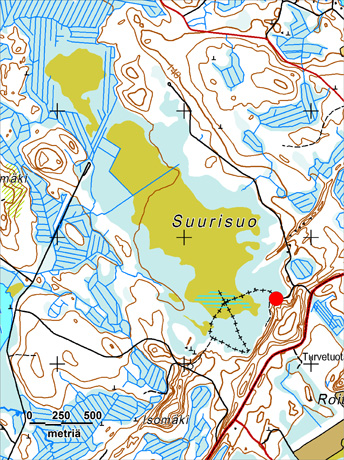
The trail starts from a promontory pushing into the swamp. The swamp edge at the border of mineral land is usually wetter than the center of the swamp. Various forests develop in the low-sedge margins. In this area, there has been a nevabog that gradually turns into a bog as the peat layer thickens, where pine is a typical species.
Suurisuo is a very old swamp, likely starting to become a swamp right after the Ice Age. Therefore, the edge forests have mostly turned into raised bogs. There are still a few small pools, whose water may originate from springs on the eastern edge.
At the edge of the swamp, lake reed grows, indicating the shores of an ancient lake and a thin peat layer. As you move further into the swamp, the lake reed disappears. Other edge species include crowberry, lake horsetail, raate, and star-sedge.
Characteristics of the nevabog include reddish sphagnum moss and pine, as well as large mounds of crowberry.
Characteristics of the bog include wet and low hollows, where narrow-leaved sphagnum moss, woolly sedge, star-sedge, and raate grow.
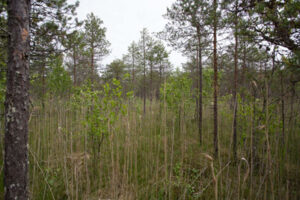
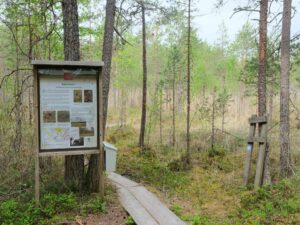
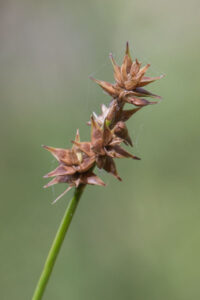
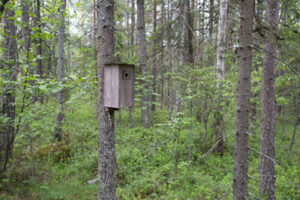
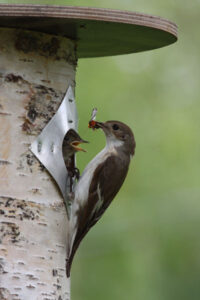
In this area, a small number of spruce trees grow. This is a spruce-dominated forest bog. Along with the spruces grow silver birches, blueberries, cloudberries, and the mossy wall-sedge is common. The bog plants are represented by slender sphagnum sedge. In the picture below, the large green leaves of the soft rush, blueberry twigs, and the sphagnum moss mat underneath are clearly distinguishable.
The edges of the swamp are also a favorable environment for elk. During the day, it can be difficult to spot elks, but their hoof prints and droppings can be seen here and there. The paths used by elks are also clearly visible along the swamp’s edges, some leading towards the open bog.

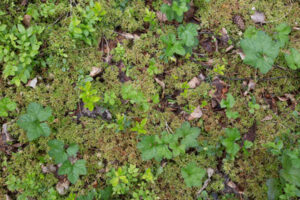

Nevabog can be found on large areas of the eastern edge of Suurisuo. Woolly sedge and raate are the most common plant species of the nevabog. In addition, the area also features bog cotton and large and small cranberries. Under the pines, bog shrubs such as cloudberry, bilberry, and crowberry grow. Knee-high dwarf birch bushes are scattered here and there.
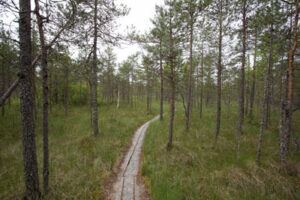
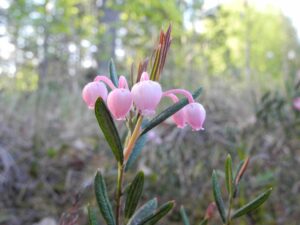

Unlike many of our other orchid species, the marsh orchid is found in many different environments. At its most abundant, it grows in moist, calcareous forests and at the edges of swamps. The color of the flowers can vary from dark red to almost white, and the leaves are marked with dark spots. The inflorescence is delicately conical, compared to the stout and oval inflorescence of the red orchid. The stalk of the marsh orchid is also slimmer than that of the red orchid. You can see red orchids around the open bogs at checkpoints 5 and 6.
The undersides of the bog flower’s leaves are very pale, while the upper surface is bluish-green. The species can be easily recognized by its foliage even when not in bloom. The pink bell-shaped flowers appear at the top of the stem in June.
The leaves of the dwarf birch are round and “curly-edged.” The dwarf birch usually remains a modest knee-high shrub. In autumn, its leaves shine in shades of red and yellow.
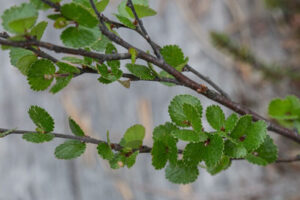
The open central areas of Suurisuo are bogs. At this point, the nevabog transitions to a bog. Among the sedges, the common species are woolly sedge, bottle sedge, and mud sedge. In some places, cotton-grass grows on the mounds. In the wettest spots, raate grows. The thickness of the peat here is about 5-6 meters. The birds of this bog type include common snipe, meadow pipit, bush warbler, and the increasingly rare yellow wagtail in Southern Finland.
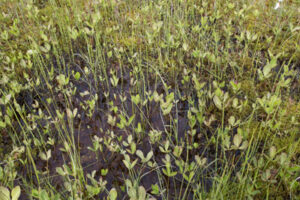
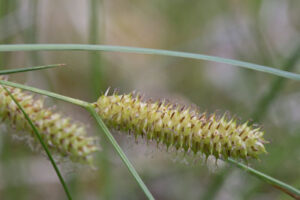

As you approach the center of the swamp, it becomes even wetter. You have arrived at rimpiletto. Especially in spring, the area is very moist, but the water surface is visible between the plants until late summer. This area is home to species like slender sedge, hoikka cotton-grass, and woolly sedge. Next to the boardwalks, a few red orchids and marsh gentians also grow. Later in the summer, the area will also bloom with white arrow grass.
Fens are lush, often calcareous types of swamps. Due to the lime, they are less acidic than other types of swamps. Therefore, the plant species in fens are more diverse, and rare swamp plants often grow in fens as well. A rimpiletto is a fen with half or more of its area covered by open water. The waters from the springs on the southwestern edge of the swamp flow into Suurisuon’s rimpiletto. The water also carries important nutrients and minerals for the plants.
In the rimpiletto, you can observe “meat-eating” plants. Sundews catch insects with the sticky drops on their leaves, while butterworts trap them with their underwater glands.
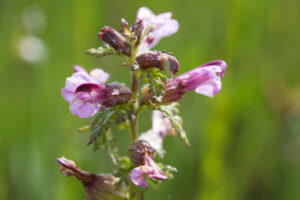
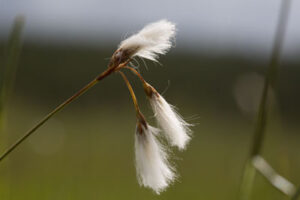

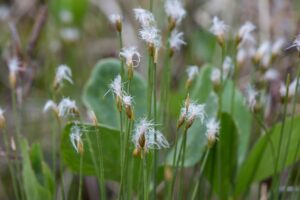
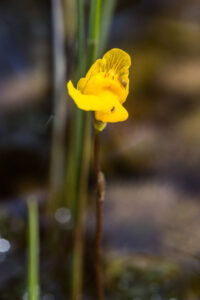
You have arrived in the middle of the southern part of the swamp, at the intersection of the boardwalks. A branch leads right towards the center of the swamp. You can walk to the end of the branch and observe birds nesting further away in the swamp. The main part of the center of the swamp is a light-colored bog. Along the edge, species such as mud sedge, rimpivihvila, bog flower, woolly sedge, white arrow grass, and rimpivesiherne grow. Can you see cranes in the swamp? What about nesting black-headed gulls?
Southwest of the boardwalk intersection, red orchids grow. The number of flowering red orchids varies from year to year, but at best, there can be several dozen.
The red orchid has a stout stem, and its inflorescence is usually relatively short and oval. The appearance of the species is distinctly different from that of the marsh orchid, which can also have a red inflorescence.
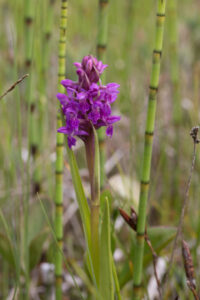
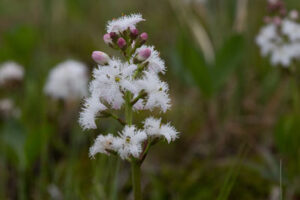
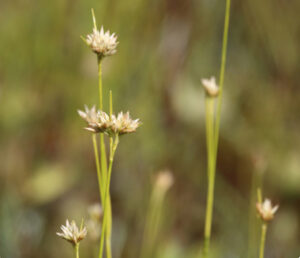
After the intersection, as you walk towards the southern edge of the swamp, you will encounter a grassy sedge bog. In the sedge bog, species such as woolly, mud, bottle, and slender sedges grow, as well as other species like reed-sedge and marsh cinquefoil. The marsh cinquefoil got its name from its three leaflets that spread out like a crane’s toes.
From such swamps, sedges and grasses were previously harvested for animal fodder. Nowadays, elk graze in the area. However, you will not see them during the day, as they prefer to move at night or in twilight. Compare slender sedge with other sedges growing in the area, such as bottle sedge or mud sedge. You will notice that all spikes of slender sedge look very similar, while the bottle sedge has distinctly different male and female spikes.
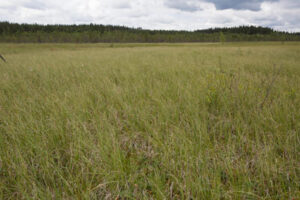
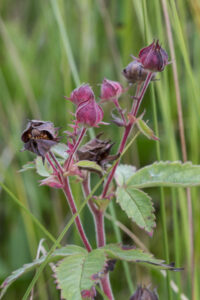
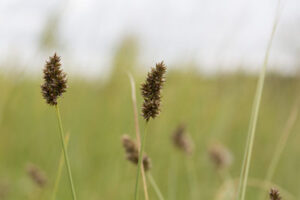
In this area, the prevailing plants are pine, along with cotton grass growing beneath it and brown sphagnum moss. Cotton grass can be distinguished from hoikka and reed cotton-grass by the fact that it has only one spike. The white spikes turn gray and dry out after flowering. Cotton grass grows in tussocks, forming thick peat. Many species of sedge and sphagnum moss also contribute to peat formation as they decompose. Peats are often classified not only by their degree of decomposition but also by the plants that form them, such as sphagnum peat or sedge peat.
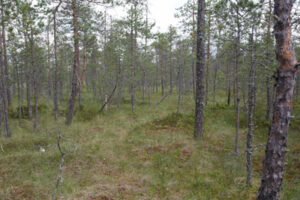

Cotton grass (Eriophorum vaginatum) The individual in the foreground is fresher, while the gray ones in the back have already passed their prime blooming time.
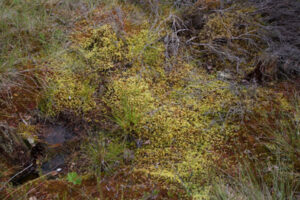 Sphagnum moss mat in the cotton-grass bog. The brown spots are brown sphagnum (Sphagnum fuscum). It often grows on drier mounds than other sphagnum species, which is useful information for swamp visitors.
Sphagnum moss mat in the cotton-grass bog. The brown spots are brown sphagnum (Sphagnum fuscum). It often grows on drier mounds than other sphagnum species, which is useful information for swamp visitors.
The typical plants of sphagnum bogs are various shrubs. A sphagnum bog with tall shrubs is referred to as a large shrub sphagnum bog, which features tall shrub species like cloudberry, bilberry, willow, bog myrtle, or low willows. In this area, large shrub sphagnum bog is patchy and mainly consists of cloudberry and bilberry. When the cloudberry blooms, its scent spreads across the entire bog area during summer evenings.
Lower typical species include large cranberry, crowberry, and bog myrtle. Other berry plants such as lingonberry, bilberry, and blueberry can still be found at the edge of the swamp.
At this point, the thickness of the peat is about 3-4 meters, reaching a maximum of about 8-9 meters in the central areas of Suurisuo.
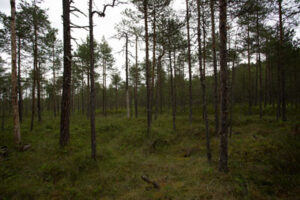

Large cranberry (Vaccinium oxycoccos)
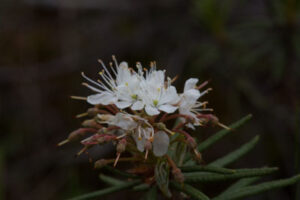
Cloudberry (Rhododendron tomentosum)
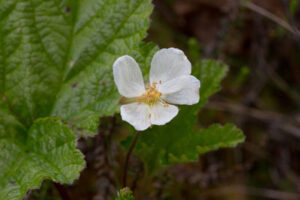
Bog myrtle (Rubus chamaemorus)
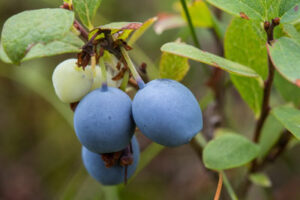
Bilberry (Vaccinium uliginosum).
At this waypoint, you reach the southern end of the swamp. The nature trail continues along the western edge of the swamp, but from here you can also climb up to Koivistonharju, where an east-west path runs along the top. At the foot of the ridge, the swamp turns into forest. The typical species is pine tussock, which also grows abundantly on the side of the swamp. Some of the forests on the ridge have been felled, and the edges of the clearings are a feeding area for white-tailed deer.
When you continue along the boardwalks to the west, a small side path leads to a spring.
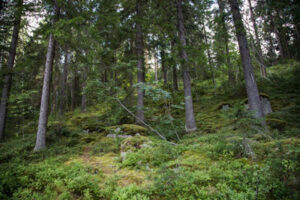
Slope of Koivistonharju. The slope is rocky in places, as the waves of the ancient Yoldia Sea washed over the moraine mound.
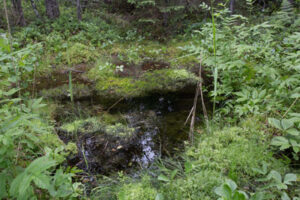
Spring
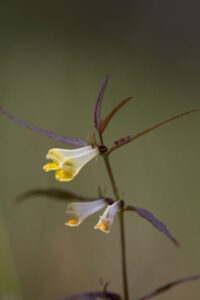
Pine tussock (Melampyrum pratense).
The western edge bogs are forest bogs, some are nevabogs, and some are spruce bogs. There are also alder forest bogs in the area. Springs are present in several places, and water flows from these springs to the southern part of the swamp. Mosses and herbaceous plants grow around the springs and their edges.
The vegetation here is different from that on the previous bog; here, the bogs grow taller grasses and herbs, as well as large ferns. The species include wood horsetail, forest alders, marsh cinquefoil, raate, lake reed, lake horsetail, common reed, and reed grass. Beautifully blooming marsh orchids are occasionally abundant. The western section of the boardwalk leads to a path towards the birdwatching tower. The path goes through the forest to a hill on the west side, where the tower is located. From the tower, there is a view of the swamp, and with binoculars or a telescope, you can observe the swamp’s birdlife without disturbing them. In spring, you can observe displaying black grouse from the tower, as well as displaying ravens.

Birdwatching tower
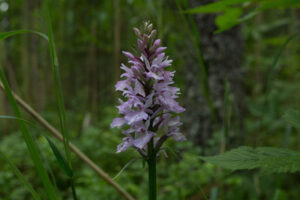
Marsh orchid (Dactylorhiza maculata)
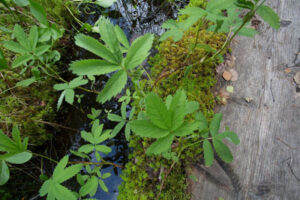
Leaves of the marsh cinquefoil (Potentilla palustris).
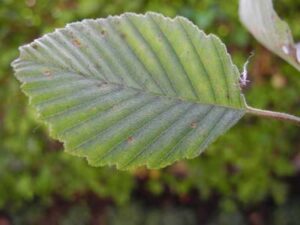
Leaves of the black alder (Alnus glutinosa).
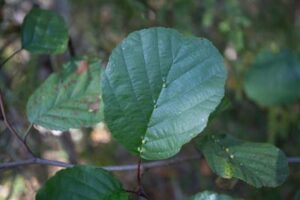
Leaves of the grey alder (Alnus glutinosa).
The tip of the grey alder leaf is usually pointed, while the tip of the black alder leaf is generally rounded and inward-curving. The black alder leaf is usually also visibly shiny.
The swamp is watery in these areas, as the water from the southern springs flows slowly northwards through this point towards the swamp’s outlet on the western side. The wettest areas are sedge bogs or rimpine bogs. The winding of the bogs in the middle of the pine fen indicates where water has flowed more strongly at times. Over thousands of years, peat growth has covered the channel, and its location may have varied.
Many insects, including dragonflies and butterflies, often move along the border of the fen and the wet spots. The swamp yellow butterfly, the swamp silver spot, and the sedge meadow butterfly are typical butterfly species of the swamp.
Swamps are typically the domain of waders and ducks. The more water there is, the more waders, ducks, or geese there will be. Suurisuo is quite dry compared to the bird-rich aphen in Northern Finland. Waders and ducks are sparse. The waders regularly seen in Suurisuo include at least common snipe, wood sandpiper, common greenshank, and the spotted crake of the edge forests. Cranes nest in the swamp, and whooper swans can be seen flying over the swamp on their way to breeding ponds. The breeding species of the edge forests include black grouse, hazel grouse, raven, and meadow pipit. Rare raptors can also be observed in the area.
Merlin can prey on insects over the swamp. Nearby nesting rough-legged buzzards, common buzzards, and sparrow hawks can be seen from the birdwatching tower. The osprey is also part of the area’s breeding species. In autumn and winter, you may also see sea or golden eagles over the swamp with good luck.
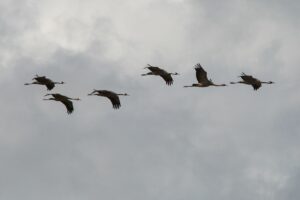
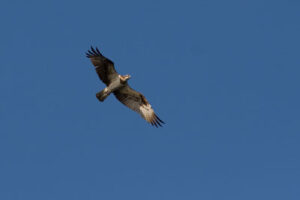
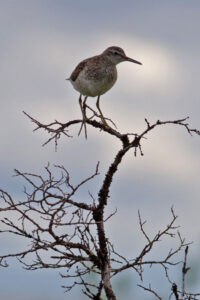
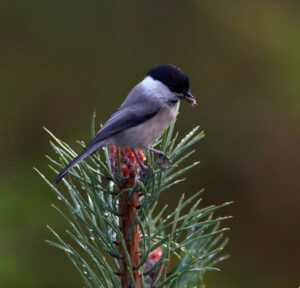
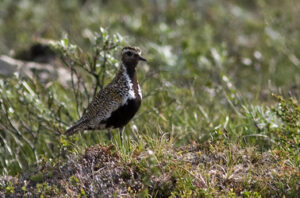
The southern loop of the nature trail is coming to an end as you approach the intersection of the boardwalks again in the middle of the swamp. The raised bog is left behind, and you transition again to an open nevabog. The shrubs end, and the vegetation shifts to the typical species of the central area of the swamp. Next to the boardwalks, you will find water milfoil, large cranberry, bottle and mud sedges, as well as round-leaved and long-leaved sundews. Sundews capture insects with their sticky drops and digest their catch. They obtain the nitrogen they need from the insects.
Next to the boardwalks, water milfoil grows in wet spots, which is easily recognized by its branched flower spikes. In the fall, the red berries of the cranberries color the edges of the mounds.

